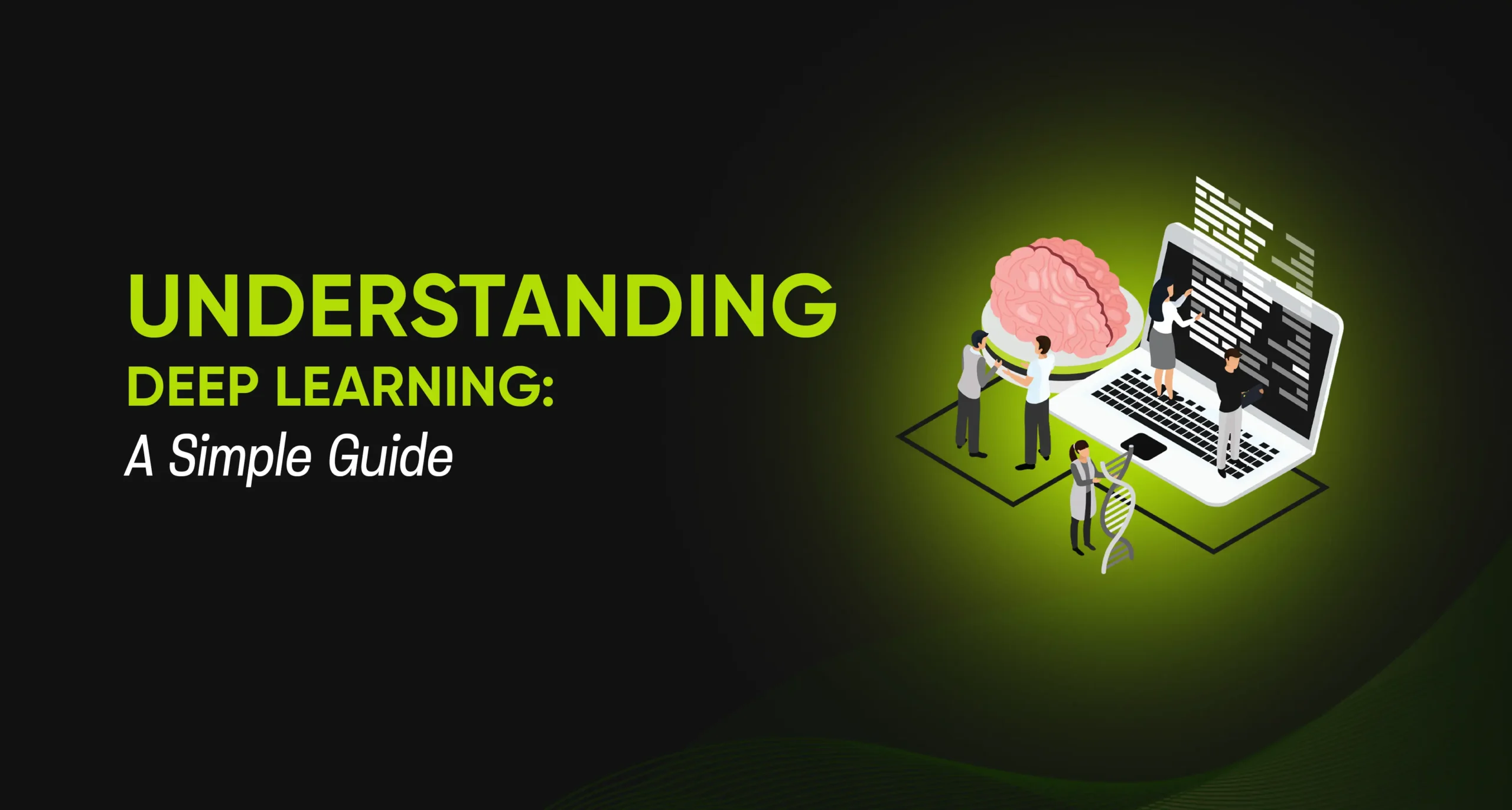Deep learning is a type of machine learning. It helps computers learn from data without human support. It works through the Linked learning steps.
These systems use layers. Each layer processes information and passes it on. This allows computers to work with complex data. Deep learning AI is useful in many fields, like computer vision and voice recognition.
It handles large amounts of data, specifically images, sounds, and videos, which have no rigid structure. As data increases, deep learning models improve. These models can also solve problems where rules are hard to define.
The main power of deep learning algorithms is that they learn on their own. They do not need step-by-step instructions. Instead, they look at data, look for patterns, and make guesses.
This makes them more useful than old methods. Many companies use deep learning to make their services better. It helps do tasks and study data that often take much longer.
How Deep Learning Works

Deep learning looks at data via multiple connected network layers. Each layer processes the data in a new way.
The first steps detect basic features, such as shapes in images. Later layers combine these shapes into more important items. This simple process helps the system find patterns in large amounts of data. The system becomes more accurate as it sees more examples.
The learning happens when the model adjusts the weights between the layers. These weights help decide the importance of the data. With more practice, the model becomes smarter.
It can predict new results with better correctness. This system is great for tasks where rules are not easy to write, like image grouping or text translation. Deep learning algorithms can keep improving as they get more datasets.
Also, many learning applications use special models like CNNs and RNNs. CNNs are for image data. RNNs are for data over time, like speech.
These models help machines understand human-like information. Deep learning AI is becoming important in the healthcare industry, the security industry, and the robotics industry.
Applications of Deep Learning
Many real-world areas use deep learning. In computer vision, it helps in facial recognition and medical imaging. For example, doctors use it to detect cancer in X-rays.
In the automotive field, it helps self-driving cars detect signs, people, and other cars. In natural language processing, it helps systems understand speech and give answers back.
Also useful in industries like finance. Here, it can detect fraud by analyzing patterns in spending. In retail, it guesses what a customer might buy next.
In entertainment, it helps recommend music and movies. Speech helpers like Siri and Alexa use it to understand spoken commands.
Learning applications are growing quickly. Many tools we use today run on deep learning algorithms. These include translation apps, chatbots, and even search engines.
These systems improve as they gather more data. Unstructured data, like texts, images, and sounds, is ideal for deep learning. That’s because the models do not need fixed formats to learn.
Handling Unstructured Data
Unstructured data means data that doesn’t follow a set format. It includes emails, social media posts, images, videos, and audio.
Old systems find it hard to work with it. But deep learning handles this data well. It reads, understands, and learns from it. This makes it powerful for modern tasks.
For example, customer reviews on websites are unstructured. Deep learning models can read these and learn what customers like or dislike. In security, systems scan video feeds to detect threats.
In education, students can read written notes. All these examples show how useful deep learning is for handling messy, real-world data.
Deep learning algorithms help companies understand unorganized data clearly. They no longer need to convert it into structured formats. This saves time and allows faster decision-making.
As more data sets become available, the models get better. That’s why companies are now storing every type of data they can access.
Ready to explore how deep learning can transform your business?
Contact us today to discover custom AI solutions for your needs.
Deep Learning Algorithms
Many different deep learning algorithms are used for different tasks. One of the most well-known is the special system for images.
CNNs are excellent for image and video recognition. Another is the recurrent neural network (RNN). RNNs are better for data that comes in sequences, like language or time series.
Then, paired systems create new data. GANs operate in pairs. One creates new data.
The other person checks if it is real or fake. People use GANs to generate lifelike images, music, and even voices.
These algorithms help machines learn from patterns, not rules. They work well on complex data, which makes them ideal for today’s needs.
The choice of algorithm depends on the type of problem. For speech, RNNs are better. For faces, CNNs are perfect.
For creating new content, GANs work best. Using the right algorithm improves results. Companies often mix algorithms to get better accuracy. Better and faster methods come as learning keeps getting better.
Data sets are the basis of deep learning. Without enough data, models cannot learn well. A good data set must be large and diverse.
It should cover all cases the model may face in real life. The model looks at examples and finds patterns. Then it applies what it learned to new data.
For instance, researchers use thousands of tagged pictures to teach models in computer vision. In voice recognition, researchers need long hours of speech. If data is missing or incorrect, the model will make errors. So, keeping data clean and updated is important.
More data means more correctness. With more training, models can handle data without a fixed format better. Learning applications become smarter.
They start giving better results. So, many groups now try to get better data. This step matters most in every deep learning job or task.
Learning Applications
Deep learning has many learning applications. In medicine, it reads scans and detects disease. In finance, it reviews thousands of transactions to find fraud.
In agriculture, it checks plant health using drone images. In manufacturing, it watches production lines for defects.
Every field uses deep learning algorithms in some way. Even marketing teams use it to understand customer choices. In law, it helps review contracts. In education, it tracks student performance.
These models can handle many types of complex data. This makes them helpful in many fields.
These applications continue to grow. As more people understand deep learning, they find new uses for it. The models also keep improving with new data sets. And tools like generative competing networks (GANs) open new paths for new ideas and automation.
Finding shapes
A key strength of deep learning is finding shapes. It does this by reviewing many examples. Over time, it learns what is normal and what is not.
This is helpful in many industries. In security, it spots strange behaviour. In banking, it detects odd transactions. In factories, it catches equipment faults before they happen.
These models learn patterns without anyone telling them what to look for. They adapt as they receive more data. This makes them extremely useful in real-life problems.
Fixed rules do not limit them. They keep learning from new inputs.
Another issue is that these models are hard to understand. Difficult to see how they decide. This helps people make better decisions. That’s why more businesses are adding these models to their systems.
Challenges in Deep Learning
Even with all its power, deep learning has challenges. It needs a lot of data sets to work well. It also needs strong computers to process this data. Not every company can afford that.
Another problem is that these models are like black boxes. Hard to know how they make decisions. This makes it difficult to trust them in some cases.
Also, they can make mistakes if the data has errors. If someone uses bad data, the model will learn the wrong thing.
Training models takes a long time. Some need days or weeks. This uses a lot of electricity and costs more.
Still, many people are solving these issues. Better hardware, smarter software, and improved learning methods are helping.
Want smarter tools for complex data tasks?
Try our deep learning-powered applications and stay ahead in your industry.
Future of Deep Learning
The future of deep learning looks bright. Better tools and bigger data sets will make models smarter. More industries will start using deep learning algorithms. Machines will do jobs that needed human thinking before.
GANs will improve over time. They will assist in creating art, music, and design. We will see more use of deep learning in daily life.
Apps will become more helpful. Machines will understand images, speech, and text better.
This future also brings new rules and ethics. People will need to check how models make decisions. Openness will matter.
But the benefits are strong. Machines will learn faster and solve harder problems. The development of deep learning is at an early stage.




2 Comments
websites
July 11, 202512:39 am
I like the efforts you have put in this, regards for all the great content.
ateeb
October 20, 202510:56 am
Thank you
Comments are closed.